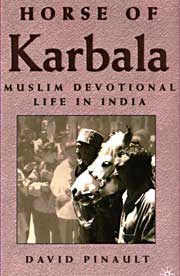The Martyrs ofKarbala: Shi'i Symbols and Rituals in Modern Iran
by KAMRAN SCOT AGHAIEThis innovative study examines patterns of change in Shi’i symbols and rituals over the past two centuries to reveal how modernization has influenced the societal, political, and religious culture of Iran. Shi’is, who support the Prophet Mohammad’s progeny as his successors in opposition to the Sunni caliphate tradition, make up 10 to 15 percent of the world’s Muslim population, roughly half of whom live in Iran. Throughout the early history of the Islamic Middle East, the Sunnis have been associated with the state and the ruling elite, while Shi’is have most often represented the political opposition and have had broad appeal among the masses. Moharram symbols and rituals commemorate the Battle of Karbala in 680 CE, in which the Prophet Mohammad’s grandson Hossein and most of his family and supporters were massacred by the troops of the Umayyad caliph Yazid.
Moharram symbols and rituals are among the most pervasive and popular aspects of Iranian culture and society. This book traces patterns of continuity and change of Moharram symbols and rituals in three aspects of Iranian life: the importance of these rituals in promoting social bonds, status, identities, and ideals; ways in which the three major successive regimes (Qajars, Pahlavis, and the Islamic Republic), have either used these rituals to promote their legitimacy, or have suppressed them because they viewed them as a potential political threat; and the uses of Moharram symbolism by opposition groups interested in overthrowing the regime.
While the patterns of government patronage have been radically discontinuous over the past two centuries, the roles of these rituals in popular society and culture have been relatively continuous or have evolved independently of the state. The political uses of modern-day rituals and the enduring symbolism of theKarbala narratives continue today.
The Tragedy of Karbalaby M.A. NaquviThis results in books that lack a cultural sensitivity or accessibility for the general reader. M.A. Naquvi's Tragedy of Karbala (122 pages, not 22!) is a welcome introduction as well as a refreshing change. The subject is the seminal event of Karbala (622 C.E.), and the author moves between past and present, providing keen insight into cultural practices connected with the martyrdom of Husayn (pbuh), grandson of the Prophet Muhammad(pbuh)*. The result is a very well-rounded book, covering an array of topics sure to interest everyone. The book is actually an address to younger generations seeking an understanding of their cultural heritage, and the links between past and present are subtley there. Everything from Iqbal's poetry on the subject, to a discussion of the effects of the Gulf War (complete with photos of the shrine) on pilgrimage to Karbala is discussed. The rites and practices connected with the event are also discussed in a separate chapter.
Horse of Karbala: Muslim Devotional Life in Indiaby David Pinault
Horse of Karbala is a study of Muharram rituals and interfaith relations in three locations inIndia: Ladakh, Darjeeling, and Hyderabad. These rituals commemorate an event of vital importance to Shi'a Muslims: the seventh-century death of the Imam Hossein, grandson of the Prophet Muhammad, at the battlefield ofKarbala inIraq. Pinault examines three different forms of ritual commemoration of Hossein's death--poetry-recital and self-flagellation in Hyderabad; stick-fighting in Darjeeling; and the “Horse of Karbala” procession, in which a stallion representing the mount ridden in battle by Hossein is made the center of a public parade in Ladakh and other Indian localities. The book looks at how publicly staged rituals serve to mediate communal relations: in Hyderabad and Darjeeling, between Muslim and Hindu populations; in Ladakh, between Muslims and Buddhists. Attention is also given to controversies within Muslim communities over issues related to Muharram such as the belief in intercession by the Karbala Martyrs on behalf of individual believers.